Content
- 0.1 Marlene (Russian Marlene)
- 0.2 Lion Heart
- 0.3 Annamarie Dream
- 0.4 Black Out (Russian Black Out)
- 0.5 Lollupop (Russian Lollipop)
- 0.6 Flore Pleno
- 0.7 Lovely Girl
- 0.8 Magic Star (Russian Magic Star)
- 0.9 Barbados (Russian Barbados)
- 0.10 Casablanca (Russian Casablanca)
- 0.11 Extravaganza (Russian Extravaganza)
- 0.12 Indian Diamond
- 0.13 Ceb Dazzele (Russian Keb Dazzle)
- 0.14 Samur (Russian Samur)
- 0.15 Black Beauty
- 0.16 Northern Carillon
- 0.17 Shocking
- 1 Outcome
- 2 1. Aphrodite
- 3 2. Golden stone
- 4 3. Detroit
- 5 4. Lollypop
- 6 5. Mapira
- 7 6. Marlene
- 8 7. Spring pink
- 9 8. Tinos
- 10 9. Fata Morgana
- 11 Lily varieties with red flowers
- 12 Photos and names of lilies with yellow flowers
- 13 Black lilies
- 14 Varieties of white lilies
- 15 Pink lilies: varieties and photos
- 16 Lilies with green flowers
Lily (lat.Lilium) is a perennial flowering plant, belongs to the class monocotyledonous, the order of lily flowers, the lily family, the genus lily. These beautiful flowers have been known since ancient times. The image of a lily is found on frescoes, vases, coins of various ancient civilizations - Greece, Rome, Egypt, Persia. For many peoples, this flower is considered a symbol of purity, innocence, purity. The name lily in translation from ancient Celtic means "whiteness", and from Old Gaulish - "white-white".
back to content ↑ Lily - description, structure, characteristics. What does a lily look like?
Lilies have a bulb, which is a shortened stem and consists of separate, adjacent scales, which are modified leaves. During the growing season, nutrient reserves are deposited in them. Scales are different in size, shape, location. In summer, they grow from the center of the bulb. The outer scales die off periodically. Depending on the species, they are the size of a grain of oat (in the oat lily (L. avenaceum)), and they are up to 10 cm in diameter (in the Henry lily (L. Henryi)). Usually, the number of scales is 8-40 pcs., But sometimes there can be 100-120 pcs., As, for example, in the bulb of the Kesselring lily (L. Kesselringianum). Each scale detached from the bulb can form a new bulb. The structure of the lily bulb is of various types: concentric, stolonal, false-columnar, rhizome. Depending on the species, the bulbs have a different color: white (Asian lilies), purple (tubular lilies), yellow (Caucasian lilies).
From the base of the bottom of the bulb, the main or sub-bulbous roots grow, for the most part perennial. With their help, the plant is kept in the ground and feeds. These types include pure white lily (L. candidum), tiled lily (L. testaceum), etc.
Most lilies have stem or supra-bulbous roots. They grow from a short underground part of the stem and serve to nourish and absorb moisture from the surface layer of the soil, and also help keep the stem upright. Such roots die off in the fall along with the stem. This group of lilies is called stem-root. Its representatives are Lily regale (L. regale), lily Henry (L. Henryi), special lily (L. Speciosum), etc.
The stem of the lily is smooth, sometimes pubescent, brownish or green in color. Its height can reach 2 - 2.5 m in oriental lilies and their hybrids, and in some wild species only 15-20 cm.
The stem is covered with sessile leaves. Their placement and shape are different depending on the type of plant. Lily leaves can be whorled on the stem, i.e. several leaves depart from one node, as, for example, in the curly lily (L. martagon), and alternately, that is, one at a time, like in the drooping lily (L. cernuum). Often these two forms can be combined: at the bottom of the whorl, and to the top, the leaves are located in a spiral. The leaves are linear or lanceolate with longitudinal venation. Their width ranges from 2 to 6 cm, and their length is from 2 to 20 cm. Usually, the leaves are larger in the lower part of the plant, and decrease towards the top. The color of the lily leaves is varied: from light green to dark purple. Their surface can be glossy or pubescent. In many species of lilies, mini-bulbs, called bulbs, form in the leaf axils, for example, in the lanceolate lily (L. lancifolium). When they hit the ground, they sprout.
The main specific features of lilies are the shape, color and size of their flowers. The size of the flower is determined by the diameter and height. The smallest flowers in wild lilies - from 2 cm in diameter, the largest - in golden (L. auratum), beautiful (L. speciosum) lilies and their hybrids - up to 30 cm.
Lily flowers are collected at the top of the stem in inflorescences, numbering from 5 to 35 or more flowers. Occasionally there are 1-2 flowers. The types of inflorescences can be as follows:
- racemose
- paniculate,
- umbrella,
- corymbose.
The lily flower consists of 6 petals, 6 stamens with large elongated anthers and a pistil. In shape, flowers are:
- tubular,
- cupped (or goblet),
- funnel-shaped,
- star-shaped (star-shaped),
- turbid,
- bell-shaped,
- flat.
In addition, as a result of crossing different types of lilies, many hybrids have appeared, in which the shape of the flower is a mixture of classical forms, for example, star-shaped flat.
The color of the petals of a lily flower can be very diverse, and as a result of hybridization, the color palette has expanded even more. Lilies come in yellow, orange, red, pink, lilac, apricot and intermediate tones. There are distinct specks on the petals, differing in number, color, size, shape and density of placement. Hybrids have been bred that do not have specks, for example, Connecticut Meid, elegant lily (Narjadnaja). Specks are varietal traits of the genus, as is the color of anthers, pollen, filaments, pistil and stigma.
Some types of lilies, such as long-flowered and oriental lilies, have a pleasant aroma, most tubular lilies smell harsh, and many Asiatic ones do not smell at all.
back to contents ↑ Where does the lily grow?
In the wild, lilies grow in the Northern Hemisphere: in Europe, Asia, several species in North America and North Africa. They occupy a vast area between 68 ° N. NS. and 11 ° n. NS. Western China, Southeast Tibet and Northern Burma are especially rich in species of lilies.
Wild lilies are found in mountainous areas and foothills, in forests, in clearings and forest edges, in wetlands or open grassy slopes. In the steppe zone, lilies rarely grow. Cultivated varieties of lilies can grow everywhere in gardens with proper care.
back to content ↑ Lily varieties, photos and names.
As a result of crossing various types of lilies, about 10 thousand hybrids of this plant arose. In 1962, the American breeder Jan de Graaf proposed a classification based on their origin and common biological characteristics. It was adopted as an international classification of lilies and is still used today, taking into account refinements and additions. According to this classification, all lilies were divided into 10 sections. The first eight sections include varieties, and the ninth - types of lilies.
Section 1. Asian hybrids (Asiatic hybrids)
Section 2. Curly hybrids (Martagon hybrids)
Section 3. Snow-white hybrids (Candidum hybrids)
Section 4. American hybrids
Section 5. Longiflorum hybrids
Section 6. Trumpet and Aurelian hybrids
Section 7. Oriental hybrids
Section 8. Interspecific hybrids (hybrids between lilies of 1, 5, 6 and 7 sections LA-hybrids, OT-hybrids, LO-hybrids, OA-hybrids)
Section 9. All wild species of lilies and their varieties.
Section 10. Hybrids of lilies not included in the previous sections.
back to contents ↑ Section 1. Asian hybrids of lilies.
It has about 5000 varieties of lilies and is the most numerous of all the sections. The height of Asian lilies is different - from 40 cm to 1.5 m. These flowers are unpretentious, frost-resistant, rarely get sick, resist pests well, they are easy to propagate. They have large flowers, 10-14 cm in diameter, of a wide variety of colors - from snow-white to almost black. They begin to bloom at the end of June and finish at the beginning of August.Asian hybrids were created by crossing East Asian species: Maksimovich's lily, tiger lily (Lilium tigrinum), David's lily (Lilium davidii), drooping lily (Lilium cernuum), dwarf lily (Lilium pumilum), Pennsylvanian lily (Lilium pensylvanicum) (Lilium concolor) and others, as well as interspecific hybrids: Lilium scottiae, Dutch (Lilium hollandicum) and spotted lily (Lilium maculatum). Plants included in this section, in turn, are divided into groups. There are three such groups. The composition of each of them is determined by the shape of the flower and its direction:
1a - flowers of a cup-shaped or cupped shape are directed upwards,
1b - flowers are directed in different directions.
1c - turban-shaped flowers are directed downward (drooping).
Several Asian hybrids have double monochromatic flowers: Aphrodite, Sphinx, Fata Morgana, EIodie; and some are double flowers in two colors: Double Sensation. Asian hybrids are odorless. Below are some of the Asian varieties of lilies.
- Aaron (Aaron) - Asiatic lily with white double flowers. It reaches a height of 80 cm. It blooms in June - July.
- Nove Cento (Nove cento) - Asiatic lily. Perianth of bright yellow-green color with a small number of dark red dots, stigma of the same shade and rich orange pollen. The diameter of the flower is 15.5 cm. The lily is not very high: from 60 to 90 cm. It blooms throughout July.
- Mapira (Mapira) – Asian variety of lilies. The flowers are claret-black, iridescent, with bright orange stamens. The diameter of the flower is up to 18 cm. The height of the lily is 130 cm. The flowering period of the Mapira lily is June-July.
- Mystery Dream (Mystery Dream) - Asian hybrid. Lily with terry light green petals. There are dark specks in the center. Not very tall plants, up to 80 cm. Blossom in July-August.
- Double Sense (Double Sensation) Is an Asian hybrid of dark red color with a white center. Lily petals are terry. Plant height 60-70 cm. It blooms in the middle of summer.
- Lion Heart (Lion Heart) - Asiatic lily of unusual, catchy color. The petals are black with a purple tint, and the tips and base of the petals are bright yellow with dark purple specks. Flowers 12-15 cm in diameter. It grows up to 60-80 cm. The lily's flowering period is June - July.
- Detroit (Detroit) - Asiatic lily. The flowers are bright red with a yellowish-orange center, the stamens are yellow-red with dark red anthers. The diameter of the flowers is 12-17 cm. The height of the lily is up to 90-120 cm. The flowering period is June-July.
back to contents ↑ Section 2. Curly lily hybrids (Martagon hybrids).
The section consists of about two hundred species of lilies. Plants reach a height of one and a half meters. They grow in different types of soil, preferring shaded, but not dark areas. Orchards are well suited for curly lily hybrids. It is better not to transplant these lilies, they do not like it. But they are frost-resistant and durable. The lilies of the second section have medium-sized flowers with a diameter of 5-8 cm, with buds looking down, the petals are twisted up. The perianth is covered with dark spots and has a varied color: yellow, pink, white, orange, dark red, brownish and a shade of light lavender. Peduncles are wide-spread. Curly hybrids come from curly lilies (L. mаrtagon), Hanson (L. hansonii), honey lilies (L. medeoloides), two-row (L. distichum), tsingtautskaya (L. tsingtauense). Martagon hybrids have a pleasant, delicate aroma. Some varieties of curly lily hybrids: Chameleon, Claude Shride, Guinea Gold, Manitoba Fox, Maroon King, Manitoba Morning, Arabian Knight Arabian Night).
- Claude Shride - marchagon is a hybrid of lilies with a height of 120 to 190 cm. The petals are curved, dark red with a purple tint, closer to the middle are covered with yellow-orange spots. Flower diameter up to 10 cm. The plant is frost-resistant and unpretentious. The lily blooms in June.
- Slate's Morning Is a curly hybrid of a lily. The flowers are about 10 cm in diameter, the petals are yellowish towards the middle and pink at the edges. The specks are brown, located in the middle of the flower. This lily grows from 90 to 150 cm in height. The flowering time of this variety is June-July.
back to contents ↑ Section 3. Snow-white hybrids of lilies.
For this section, the name European hybrids is often used, since they descended from European species of lilies, such as the snow-white lily (L.candidum), chalcedony (L. chalcedonicum) and other European species, except curly lily. And the name "snow-white hybrids" was given to this section due to the fact that it includes plants whose flowers are painted in white or slightly yellowish shades. The perianth is tubular or broadly funnel-shaped. The flower reaches 10-12 cm in diameter and smells good. The stem is high: 120-180 cm. Snow-white hybrids of lilies are whimsical, they need attention and care, they are often affected by fungus, they do not tolerate cold well, they need to be covered for the winter. These lilies love sunny areas. The best varieties of Candidium hybrids include Apollo.
- Apollo - Candidium lily hybrid. Blooms from June to July. The flowers are snow-white with small dark dots in the middle, fragrant, 10-12 cm in diameter. Plant height from 80 to 120 cm.
- Madonna (Madonna) - a snow-white hybrid of lilies. A pure white flower with a diameter of 10-12 cm, tubular with bent petals. Blooms in June - July. Has a delicate aroma.
back to contents ↑ Section 4. American hybrids of lilies.
These are the descendants of species growing in North America: leopard lily (L. pardalinum), Columbian lily (L. columbianum), Canadian lily (L. canadence) and others (140 items in total). They reach a height of 2 m. Flowering time is July. Lily flowers are tubular or bell-shaped, 10-12 cm in diameter and have a wide variety of colors. The flowers are often two-colored and covered with large specks. Most plants have a pleasant scent. At home, these hybrids are unpopular. They prefer slightly shaded places, but do not like transplanting. American hybrids are whimsical: they need regular watering and winter shelter. Here are some varieties of American lily hybrids: Lake Tulare, Shuksan, Afterglow, Buttercup.
- Lake Tulare (Lake Tulare) Is an American hybrid of a lily. The petals are strongly curved, yellowish with dark red dots in the middle, pinkish at the edges. It grows in height up to 120 cm.
- Afterglow (Afterglow) Is an American hybrid. Lily flowers drooping, turban-shaped, crimson-red, with large dark spots. Tall plant - up to 2 m.
back to contents ↑ Section 5. Long-flowered hybrids of lilies.
They come from long-flowered lily (L. longiflorum), Formosan (L. formosanum), Philippine (L. phylippinense) and other tropical and subtropical lilies. The average height of the whole plant is from 1 to 1.2 m, and the height of the flower is 15-20 cm. The flowers are bell-shaped. The buds are multidirectional, drooping. The petals are painted in shades of white. They have a delicate aroma. Long-flowered lilies are more afraid of frost than any other species, since the "parent" species growing in the subtropical zone of southern Japan are not accustomed to the cold. In colder latitudes than the subtropics, these plants are grown in greenhouses. The best varieties of long-flowered hybrids are: White Heaven, White Elegans, White Fox.
- White Heaven Is a long-flowered hybrid of a lily that grows up to 90-110 cm in height. The flowers are 15 cm in diameter, white with a greenish center and slightly curled petals. Flowering time July - August.
- White Fox - a long-flowered hybrid of white color with a slight yellowness. It reaches a height of 130 cm.The length of the flower tube is up to 16 cm, and the diameter is up to 12 cm.
back to contents ↑ Section 6. Tubular and Orleans hybrids of lilies.
Orleans hybrids - the result of crossing the Henry lily (L. Henryi) with the following types of lilies: royal lily (L. regale), glorious (L. gloriosum), Sargent (L. sargentiae), sulfur (L. sulphureum), white-flowered (L. leucanthum) and others. There are up to 1000 varieties in this group. The section is divided into 4 subsections, taking into account the shape of the flowers and their position on the stem.
but. Tubular (like a regal lily).
b. Cup-shaped (with wide open leaves).
in. Drooping (having a turban-like shape).
d. Star-shaped (flat).
The flowers of tubular hybrids are large, from 12 to 18 cm in length, with a very strong aroma. The colors are very different. Plants have a height of 120-190 cm. Viral and fungal diseases are not terrible for tubular hybrids. They are hardy, cold-resistant plants that love sunny areas. They need good drainage for their successful growth.Some varieties of tubular and Orleans hybrids are: Pink Perfection, African Queen, Royal Gold, Golden Splendor, Lady Alice, Regale.
- African Queen (African Queen) - a very aromatic variety of lilies, which belongs to the tubular hybrids. It has a racemose inflorescence of 3-6 upward, large flowers, 15-16 cm in diameter. The flower is orange-apricot, brown strokes are located on the outer side of the petals. The height of these lilies reaches 120-140 cm. The flowering period of this variety of lilies is July-August.
- Pink Perfection (Pink Perfection) - a variety of lilies from Orleans hybrids. Flowers 11 cm in diameter and 13 cm long have lilac-pink petals, light green staminate filaments, a brown column above and bright orange anthers. They are collected in racemose inflorescences of 5-7 pieces. Plant height reaches 180 cm. The flowering period is August.
back to contents ↑ Section 7. Oriental hybrids of lilies.
Were obtained from species growing in East Asia: beautiful lilies (L. speciosum), golden (L. auratum), Japanese (L. japonicum), reddish (L. rubellum), as well as their hybrids with the Henry lily (L. Henryi) ... These include about 1300 varieties. These lilies are very whimsical and love warmth. They reach a height of 40 cm to 1.2 m. The flowers are huge (up to 30 cm in diameter) with corrugated petals painted in white, red and pink tones. The varieties Miss Lusy and Double Star have double petals. A distinctive feature of the color is the edging along the edge of the petals or a strip in the center. Lilies bloom from August to September. In this section, 4 subsections are also highlighted according to the shape of the flowers:
but. lilies with a tubular flower shape.
b. lilies with a cupped flower shape.
in. Lilies with a flat flower shape.
d. Lilies with petals bent back.
The best varieties of oriental lily hybrids: Miss Birma, Tarden Party (Garden Party), Stargazer, Casa Blanca, Crystal Star, Le Reve, Salmon Star Star).
- Canberra (Canberra) - a variety of lilies, which belongs to oriental hybrids. Blooms from August to September. The flowers are crimson, there are dark spots on the petals, the middle is yellow. Plant height - up to 180 cm.
- Stargazer - an oriental hybrid with upward-facing crimson-pink flowers, 15-17 cm in diameter. Lily petals are wavy at the edges, almost completely covered with oblong, convex, dark red spots. Lilies bloom in August and have a strong aroma. Plant height - 80-150 cm.
- Salmon Star - an oriental hybrid, growing up to 2 m. Flowers are large, up to 20 cm in diameter and more. Flowering time is June-July. The petals are of a delicate salmon color, covered with bright orange specks, corrugated. These lilies have a very strong scent.
back to contents ↑ Section 8. Interspecific hybrids of lilies.
This is a section that includes all interspecific hybrids of lilies that were not included in the previous sections. Their name consists of the first letters of the species of their "parents": LA, OT, LO, OA.
LA hybrids (longiflorum asiatic) - hybrids of Asian lilies (Asiatic) and longiflorum lilies (Longiflorum). Their number, which is about 200 varieties, continues to increase. They have the best qualities inherent in parents: endurance and varied color (from Asian hybrids), the ability to develop rapidly (from long-flowered). Thanks to the latest LA, hybrids have large flowers, as if made from wax. They bloom profusely throughout June and July, along with Asian species. Favorable places for growth are open or slightly shaded areas. LA hybrids are winter-hardy.
OT hybrids obtained by crossing oriental lilies (Oriental) and tubular lilies (Trumpet). They were first obtained in the 90s of the twentieth century. Large, directed to the sides or upward, wide-bowl or funnel-shaped flowers form up to thirty inflorescences. The color can be multi-tone or monochromatic: yellow, orange, red or pink. Flowers appear in July - August and smell strong. Plants are tall, with sturdy stems. For their height, reaching 180 cm, and sometimes 2.5 meters, they are called "Lilies-trees".
LO hybrids arose not so long ago. By crossing long-flowered (Longiflorum) and oriental (Oriental) hybrids in various combinations, breeders obtained LO-hybrids. Tall plants, up to 100 - 130 cm, tolerate sun and shade equally well.Delicate flowers, colored in yellow and a combination of white and pink, have a short tubular or funnel shape. The diameter of the flowers is 10-20 cm. The aroma of lilies is very pleasant.
OA hybrids - another completely new, promising group, obtained from the crossing of oriental (Oriental) and Asian (Aziatic) hybrids. Directed mainly upward, the flowers of these lilies are slightly smaller than those of oriental hybrids, but no less beautiful. The leaves of this group of lilies are wider than those of the oriental ones. Plants are unpretentious.
- Pretty Woman (Pretty woman) - OT-hybrid of lilies up to 180 cm high. Blossoms in July - August. The flower is very large, cream color, turning into pink towards the center.
- Triumphant(Triumphator) - LO-hybrid. Lily 120-140 cm high with very large flowers up to 25 cm in diameter. The flower has wide white petals with a pink-crimson center, bright yellow-green nectaries, orange anthers and a yellowish-green stigma. Lily Triumphator blooms in July-August.
- Anastasia (Anastasia) - OT-hybrid up to 150 cm high. The curved petals are pink, the edges and center of the flower are white. Also, the flower has streaks of crimson color and specks inside. Lily blooms in July.
- Shocking (Shocking) - OT-hybrid of lilies. The petals are bright yellow, inside are red-brown strokes, with red dots, from the outside they are greenish-yellowish. The stigma is purple with a green top, the nectaries are yellow-green, the anthers are dark red-brown. The flowers are large, up to 21 cm. The height of the plant is up to 130 cm. Lilies of this variety bloom in July - August.
back to contents ↑ Section 9. Species lilies.
This includes about a hundred species of wild-growing lilies, common in southern Europe, eastern Asia, in the mountains of India, and several species of northern America. In 1949, the English scientist Comber classified species lilies based on their geography and biological characteristics. This classification was revised and supplemented by M.V. Baranova 1988.
Section 10. Hybrids of lilies not included in the previous sections.
- Lady Alice (Lady Alice) Is a rare hybrid. The flowers are turban-shaped with strongly curved petals of apricot-orange color, with white edges and light brown dots. The stamens are very long. The stem of the plant is 120-150 cm, covered with dark brownish-purple spots. Lily blooms in July-August.
back to contents ↑ Classification of lilies.
Lily is a plant that has a large species composition. Growing over vast territories, these flowers differ from each other not only in the structure of bulbs, flowers, inflorescences and seeds, but also in the requirements for soil, humidity, and temperatures. There are several classifications of lilies, each of which subdivides them into a number of groups. The classification of V.M. Baranova, adopted in 1988. According to this classification, the genus of lilies is divided into 11 sections, which include the following types:
Section 1. Lilium.
L. snow-white or white -L. Candidum.
Section 2. Eurolilium
L. Albanian - L. albanicum,
L. carniola - L. carniolicum,
L. Kesselringa - L. kesselringianum,
L. Ledebouri - L. ledebouri,
L. one-brother - L. monadelphum,
L. ciliated (pubescent) - L. ciliatum,
L. Pyrenean - L. pyrenaicum,
L. pomponnaya - L. pomponicum,
L. Sovicha or Shovitsa - L. szovitsianum,
L. Chalcedonian - L. chalcedonicum,
L. artvinskaya - L. artvinense,
L. pontic - L. ponticum,
L. Rodopskaya - L. rhodopaeum.
Section 3. Martagon
L. Hanson - L. hansonii,
L. two-row - L. distichum,
L. curly or Saranka - L. martagon,
L. weak - L. debile,
L. medeoloidnaya - L. medeoloides,
L. tsingtao (tsingtau) - L. tsingtauense.
Section 4. Pseudomartagon
L. proud or magnificent - L. superbum,
L. Canadian - L. canadence,
L. leopard -L. Pardalinum,
L. Michigan - L. michiganense,
L. Gray - L. grayi,
L. Michaud - L. michauxii,
L. rainbow - L. iridollae,
L. Pitkin - L. pitkinense,
L. Vollmer - L. vollmeri,
L. Wiggins - L. wigginsii,
L. Primorskaya - L. maritinum,
L. western - L. ociidentale,
L. Kelly - L. kelleyanum,
L. small - L. parvum,
L. Parry - L. parryi,
L. Humboldt - L. humboldtii,
L. eye - L. icellatum,
L. Bolander - L. bolanderi,
L. Columbia - L. columbianum,
L. Washington - L. washingtonianum,
L. blushing - L. rubescens,
L. Kellogg - L. kelloggii.
Section 5. Archelirion
L. Alexandra - L. alexandrae,
L. Henry - L. henryi,
L. golden - L. auratum,
L.reddish - L. rubellum,
L. beautiful - L. speciosum,
L. Japanese - L. japonicum,
L. Konishi - L. konishii,
L. Rostorn - L. rosthornii,
L. noble - L. nobilissimum.
Section 6. Regalia
L. white-flowered - L. leucanthum,
L. sulfur-yellow or countless-leaved - L. sulphureum = L. myriophylium, L. Brown - L. brownii,
L. Wallich - L. wallichianum,
L. longiflorum -L. Longiflorum,
L. nilgirskaya (neilpherskaya) - L. neilgherrense,
L. Sargent - L. sargentiae,
L. philippine - L. philippinense,
L. Taiwanese - L. formosanum,
L. regal or royal - L. regale.
Section 7. Sinomartagon
L. David - L. davidii,
L. dwarf - L. pumilum,
L. lankongskaya - L. lankongense,
L. drooping - L. cernuum,
L. pleasant - L. amabile,
L. papillary - L. papilliferum
L. taliyskaya - L. taliense,
L. lanceolate or tiger - L. lancifolium = L. tigrinum,
L. Leichtlin - L. leichtlinii,
L. pseudo-tiger or Maksimovich - L. pseudotigrinum,
L. Willmott - L. Willmottiae,
L. Chinese - L. sinensis,
L. Duchaertre - L. duchaertrei,
L. Ward - L. wardii, L. Nina - L. ninae,
L. Tien Shan - L. tianschanicum.
Section 8. Sinolirium
L. one-color - L. concolor,
L. Bush - L. buschianum.
Section 9. Pseudolirium
L. pensylvanicum or daurian - L. pensylvanicum = L. dauricum,
L. onion-L. bulbiferum,
L. orange - L. aurantiacum,
L. spotted - L. x maculatum,
L. Philadelphia - L. philadelphicum,
L. Catsby - L. catesbaei.
Section 10. Nepalensia
L. calloused - L. callosum,
L. Nepalese - L. nepalense,
L. primrose - L. primulinum,
L. Poilena - L. poilanei,
L. woody - L. arboricola,
L. multifoliate - L. polyphyllum,
L. Farge - L. fargesii,
L. yellowish -L. Xanthellum,
L. Stewart - L. stewartianum.
Section 11. Lophophora
L. adorable - L. amoenum,
L. Baker - L. bakerianum,
L. George - L. georgei,
L. Prince Henri - L. henrici,
L. comb-bearing - L. lophophorum,
L. macklin - L. mackliniae,
L. stunted - L. nanum,
L. strange - L. paradoxum,
L. youthful - L. sempervivoideum,
L. Sheriff - L. sherriffiae,
L. Suli - L. souliei,
L. three-headed - L. triceps.
back to content ↑ Types of lilies, photos and names.
Below is a description of some types of lilies.
- White lily, she white lily or lily pure white (lat.Lilium candidum). The plant reaches 100-150 cm in height. The bulb is round, up to 15 cm in diameter, consists of white or yellowish lanceolate scales. The stem of the lily is smooth, light green in color, sometimes with purple strokes. Leaves are smooth, light green, wider at the bottom than the top. The lower leaves are collected in a rosette, and up the stem are arranged alternately. The flowers are broad-funnel-shaped, pure white. The pollen is light yellow. The lily fruit is a capsule. White lily blooms from June to July. The homeland of the plant is the Mediterranean. White lilies grow in southern Europe, southwestern Asia, and also in Russia (everywhere up to the taiga zone). The plant propagates by scales and seeds. This flower has long been used in cosmetology and medicine.
- Curly lily (lat.Lilium martagon) has several names: Saranka, Sardana, Sarana, Badun, Maslyanka, Tsar's curls, Forest lily, Turkish lily. The plant reaches a height of 150 cm. The bulb is ovoid, up to 10 cm in diameter. Consists of narrow-lanceolate scales of golden yellow color. Stem cylindrical, green with dark purple streaks, glabrous or pubescent. The leaves are broadly lanceolate, at the bottom they are collected in whorls of 6-10 pieces, alternately located at the top. Lily flowers drooping, 3-4 cm in diameter, collected in racemose inflorescences. The perianth has a turban-like shape and a dull lilac-pink color with dark brown spots. The pollen is brownish red. There are varieties of curly lilies with flowers ranging from white to almost black. This lily blooms in June. It is unpretentious, frost-resistant. Her homeland is Eurasia. The curly lily grows in plains, meadows, mountains and foothills, in broad and small-leaved forests from Portugal in the west to the headwaters of the Lena River in the east, and from the mouth of the Yenisei in the north to southern Mongolia in the south. Lily reproduces by dividing the nests of bulbs, bulbous scales. In culture, this lily is used as an ornamental plant. Both the main species and its subspecies are used in hybridization. Forest lily bulbs can be eaten as a condiment. The plant is a honey plant and is used in medicine and veterinary medicine.
- Lily Henry (lat.Lilium henryi) named after the Irish botanist Augustine Henry who first found it. Known since 1889. The lily height varies from 150 to 250 cm. The stem of the plant is cylindrical, curved, green, with dark purple strokes. Leaves are lanceolate, often crescent-curved, glabrous, dark green.The lily inflorescence is panicle-shaped, consists of 10-20 drooping flowers on long pedicels. The form of the perianth is weakly turbid, the color is light orange with dark relief spots, strokes, papillae and a bright green nectar-bearing groove. A garden variety of Henry's lily with light lemon-yellow flowers is known. The pollen of the flower is dark brown. Lilies bloom from August to September inclusive. The flowers of this plant are fragrant and hardy. The homeland of Henry Lily is Central China. It reproduces by seeds, scales, stem underground bulbs - babies. Used in hybridization.
- Lily regal (lat.Lilium regale), she royal lily, tibetan lily, regale lily, Chinese lily... One of the most common species in culture. Found by the English botanist Ernest Wilson in the Chinese province of Sichuan. The plant reaches a height of 120-180 cm. The bulb of the plant is round, 10-15 cm in diameter, consists of large lanceolate scales of yellow or yellowish-brown tones, becoming dark purple in the light. The stem is ribbed, gray-green in color with dark purple strokes. The plant has supra-bulbous roots. Leaves are linear, arranged alternately. Inflorescences of the regal lily are racemose, contain up to 30 flowers. The flowers are tubular, up to 15 cm long and 10-15 cm in diameter. Lily petals are white, pinkish-brown outside, with shine and yellowness in the pharynx. On the inside there is a green nectar-bearing furrow. The pollen of the flowers is bright yellow. The royal lily blooms in mid-July. It is a highly aromatic plant that is resistant to various diseases. The disadvantage is the instability to late frost. The royal lily reproduces by seeds, scales, stem underground bulbs. It is widely used in breeding and hybridization. A large group of Tubular hybrids originated from the regale lily.
- Lily dwarf (thin-leaved, short, low, narrow-leaved) (lat. Lilium pumilumLilium tenuifolium) has a height of 20-60 cm. The bulb is white, ovoid, up to 4 cm in diameter. The lanceolate scales fit snugly against each other, creating the appearance of one whole. The stem is straight, glabrous or covered with coarse hairs. The stem color is green, rarely purple. In the middle, it is densely covered with alternately arranged leaves, the top and bottom of the stem are bare. Flowers are bright red, turbid, drooping, solitary or 2-8 flowers in loose racemose inflorescences. Lily blooms in mid-July. Dwarf lilies grow in the Altai Mountains, Mongolia, China, the Korean Peninsula and Japan. The plant is found on open rocky slopes among grasses and low bushes. In Russia, the thin-leaved lily is widespread from the Yenisei to the Sea of Japan. Winter hardy. Propagated by seeds. Dwarf lily is widely used in breeding.
- Tiger lily (lanceolate) (lat.Lilium lancifolium, formerly Lilium tigrinum) - a plant of average height from 100 to 120 cm. The bulb is loose, ovoid, consisting of oval white scales. The stem is ribbed, pubescent, brown. Leaves are lanceolate, arranged in regular order. Bulbs are in the axils of the leaves. Lily flowers are turbid, drooping, 2-15 pieces per inflorescence. The pollen is brown. The color of the lily is orange-red with black spots, reminiscent of the predatory color of a tiger, cheetah or leopard. The plant blooms in August. The homeland of this species is East China, Japan, the Korean Peninsula, the Kuril Islands, and South Primorye. Tiger lilies do not set seeds, they multiply by dividing bulbs, bulbs and underground bulbs.
- Lily Bush (lily is beautiful, pretty) (lat. Lilium buschianumLilium pulchellum) is of East Asian origin. The tubers of this lily were sent from Russia to England, where the plant was described by the English botanist K. Lodiges in 1830 and was named Bush's lily. In Russia in 1839 the description of the flower was compiled by the German botanist F.B.Fischer, serving in Russia. For its miniature size and beautiful flowers, the lily was named Pulchellum - pretty. Plant height is 30-60 cm. Small bulbs are ovoid. The stem is thin, smooth, green in color. Leaves are narrow-lanceolate, rarely arranged, in regular order. Lily flowers are stellate, broad-funnel-shaped, directed upward, single, less often collected in a brush of 2-5 flowers. The diameter of the flower reaches 6-8 cm. The color of the lily is reddish-orange, less often light red. Outside, the flower can be naked or pubescent. Beautiful lilies are common in Eastern Siberia (Transbaikalia, Zeya-Bureinsky region, Ussuriysky Territory). They grow in meadows, well-lit treeless slopes, in sparse bushes, on the edges of small-leaved forests. Lilies bloom in June-July. The plant is used in hybridization and has also been widely used in medicine.
- Lilia daurskaya (Pennsylvania) (lat.Lilium pensylvanicum, Lilium dauricum) described in 1805. The Pennsylvanian lily got its name by mistake, because this plant was unknown in North America. When the origin of this flower was found out, its nomenclature name was not changed. Now in the literature there are two names for this species - Pennsylvanian lily and Daurian lily. Plant height is 120 cm. The round bulb has a diameter of up to 8 cm and consists of white lanceolate scales. Stem slightly ribbed or round, glabrous or tomentose. Lily leaves are alternate, dark green. Inflorescences are corymbose, 2-10 flowers, occasionally solitary flowers. The form of the perianth is cup-shaped. Leaflets with dark spots and papillae along the nectar-bearing gland. Daurian lily flowers are distinguished by a variety of colors: yellow, orange, red, dark red. The homeland of this flower is vast expanses from the Yenisei in the west to the island of Hokkaido and Kamchatka in the east and from 64 ° N. to Mongolia, the Korean Peninsula and Northeast China in the south. The Daurian lily is found among the shrubs of the forest and forest-steppe zones, in damp floodplain meadows, forest glades and forest edges. According to the totality of features, several forms of this lily are distinguished: tiger, ribbed, alpine, typical. By the timing of flowering, 2 forms are distinguished. The first is early flowering, undersized, strongly pubescent, has 1-2 dark red flowers with a large yellow spot at the base. The second is late-flowering, tall, with numerous, evenly colored red flowers. Daurian lily propagates by seeds, baby bulbs, scales, pieces of scales.
back to contents ↑ Bush lily.
In everyday life there is such a name as bush lilies. This is not a completely correct concept, since the bush assumes the presence of several trunks, and all lilies, regardless of the type, have one trunk growing from one bulb. But in some species of lilies, daughter bulbs develop annually on the bottom of the bulb or on its underground roots, and a bulbous nest is obtained, as, for example, in the leopard lily (L. pardalinum), the nest of which can consist of hundreds of bulbs. If the daughter bulbs are not separated and transplanted, then a whole bush will indeed grow around the mother bulb. Often bush lilies are called lilies that have not single flowers, but inflorescences. In this case, almost any type and variety of lilies, including the types described above, are suitable for this name.
back to content ↑ Pyramidal lilies, varieties and photos.
Pyramidal is another incorrect name for lilies. In the world of flowers, there is a phenomenon of fasciations, stalks splicing. The phenomenon got its name from the Latin word fascis, which means "bundle". Fasciation occurs both from adverse factors: injury to the bulbs, lack or excess of light, moisture, heat, and from “too favorable”: overfeeding with all kinds of stimulants, fertilizers.The result is the accretion of growth points at the time of inception and the fusion of deformed shoots. Some varieties of lilies, such as Aphrodite, Elijah, Fleur, Red Hot and especially Marlene, are prone to fasciation. But in any case, this does not always happen, and it is impossible to predict in advance whether the lily will be pyramidal or not.
- Lilium Marlene Is a hybrid of Asiatic lilies and Longiflorum lilies. It got its name in honor of the world movie star Marlene Dietrich. This variety is called the pyramidal lily. Its inflorescences, which have increased as a result of accretion, can number up to a hundred buds. The diameter of the flowers is 15-20 cm. The color of the petals varies from light pink at the tips to white in the center, the inner petals are covered with small dark red spots. Plant height 90-100 cm. The leaves of the Marlene lily, growing in succession, have an elongated and pointed shape. The phenomenon of fasciation, although inherent in the Marlene lily, does not happen with every plant.
back to contents ↑ Planting and caring for a lily.
Bright, catchy, showy lilies are a decoration of any garden. But in order for these flowers to please gardeners with their beauty every year, attention and care are needed. The soil for planting lilies should be moist, loosened and free of weeds. The site must be selected taking into account what type or variety of lilies will be planted on it, since some varieties like shaded places, and some are sunny. In addition, you need to take into account which plants grew there before. It is good if these were legumes, some annual flowers, such as petunia, or vegetables - cucumbers or radishes, but after strawberries, onions and garlic, the earth should take a break. It is not necessary to plant lilies close to trees, where the shade is very large and the soil is dry. Plants, especially those with large flowers, need protection from the winds, so it is good when shrub plants grow around them - they will give shade and protect from the wind.
Different types and varieties of lilies love different types of soil: acidic, alkaline, neutral, etc., for example, Asian hybrids prefer a slightly acidic environment, tubular hybrids slightly alkaline or neutral. With this in mind, various fertilizers, top dressing are applied, drainage is arranged.
For lilies, moderate soil moisture is important: these plants do not like an excess of moisture and cannot stand water stagnation. Watering is usually carried out at the root, since the leaves do not react well to water ingress. Watering lilies is important throughout the summer and part of autumn, because at the end of the summer season, roots grow back and nutrients accumulate for the winter.
If the lily is planted in well-fertilized black soil, then feeding is not needed, but if the soil does not have enough fertilizers, then before watering or with it, you need to make preparations to improve the life of the plant. For this, it is necessary to protect the soil from overheating and evaporation of moisture by mulching with sawdust and grass.
Bulbs are planted mainly in the fall, but lilies can also be planted in the spring. The optimal time for planting: in the fall - in September, in the spring - in May. Before planting, the lily bulbs must be soaked for 30 minutes in water or potassium permanganate, and then planted to a depth of 10-20 cm. For the winter, especially when the early cold weather sets in, planting must be carefully insulated with a covering material.
Lilies begin to bloom fully and profusely only in the second or third years. In the first year of planting, until normal flowering and growth is achieved, the buds are selectively or completely removed, and the plants that have not gained strength are tied to a support. For 4-5 years of growth, lilies must be separated and transplanted, since the development of the plant slows down and the flowering weakens.
back to contents ↑ Diseases and pests of lilies.
There are many diseases and pests that can not only spoil the appearance of lilies, but also completely destroy them.
Fungal infections.
Plants can be affected by fungal infections such as gray mold (botrytis), fusarium, phytium, blue mold, penicillosis, rust. High humidity and improper care contribute to the spread of fungi. Fungi affect all parts of the plant from the bulb to the petals. These diseases can be identified by their appearance: plaque appears on the bulbs, spots, strokes, mucus appear on the stems, leaves and flowers. The bulbs start to rot. To combat fungal diseases, various medicinal solutions are used, fungicides are used to treat the affected bulbs, and the plant itself is sprayed. To avoid fungal diseases, you need to take preventive measures - proper care, avoidance of excess moisture.
back to contents ↑ Viruses.
There are several viruses that lilies are susceptible to: cucumber and tobacco mosaic virus, tulip variegation virus, rosette disease. These diseases are spread by insect pests, most often aphids, or they are transmitted through infected garden tools. Signs of viral diseases: yellowing and deformation of the stems and leaves of the lily, the appearance of age spots on the petals and leaves, the cessation of plant growth. To prevent the spread of these diseases, it is necessary to cut off and destroy the affected areas, spray diseased plants with the recommended preparations, and disinfect garden tools.
back to contents ↑ Pests.
There are about 15 species of insects that harm lilies in various ways, which leads to a slowdown in their growth and death, for example:
- spider mite feeds on plant sap,
- lily fly damages buds,
- Medvedka, Khrushch (May beetle larva), onion fly-hoverfly spoil the bulbs,
- squeak beetle (lily beetle, lily rattler) and its larvae eat leaves.
In addition, insects carry viruses. To combat these pests, spraying with solutions containing various insecticides is used. If some insects, such as beetle, are affected, dig up the soil deeply and select the larvae before planting the bulbs. For the bear it is necessary to arrange special traps, and for the winter to dig deeply the soil to destroy the wintering stages.
In addition to insects, small mammals harm lilies: mice, rats, water rats, moles. Moles do not eat bulbs, but, breaking through the tunnels, they damage the roots of plants. In addition, mice and water rats make their way along these passages and destroy the bulbs. It is not recommended to cover plants with straw for the winter, since mice are found in it in large quantities, eating both bulbs and ground leaves. In the fight against these pests, traps, mousetraps, poisons, and electronic scarers are used.
back to contents ↑ Interesting facts about lilies.
- Since ancient times, lilies have been used in perfumery, cosmetology, and medicine.
- In some countries, such as Japan, China, Korea, lily bulbs are also eaten raw, and they are used for making soups, salads, and meat dishes.
- As a symbol, lily flowers have adorned and adorn the coats of arms of countries (France), cities (New Orleans, Detroit, Daugavpils), provinces (Canadian Quebec, Dutch Flevoland); old noble coats of arms in European countries; old coins, vases, frescoes; modern logitopes of various organizations, teams, movements.
- The ancient Persian city of Susa got its name from the lilies that grew on the site of its foundation.
- From the name of this flower comes a female name, which has its own version in different languages: Lily - in Russian, Lily - in French, English, Susanna, Shushanik - in Armenian, Asuzena - in Spanish, Yuri - in Japanese.
- There are legends about lilies in Ancient Egypt, Ancient Greece, Ancient Rome, in the states of Medieval Europe.
- Lily is also mentioned in the Bible. Many paintings have been painted by famous artists based on the biblical plot of the Annunciation.On them, the Archangel Gabriel approaches the Virgin Mary with the news of the future birth of the Savior, holding a lily flower in his hands, as a symbol of purity and purity. There is an icon "Fadeless Color", where the Mother of God holds the lily.
Did you like the article? Share with your friends:
Lilies varieties with photos and names
Every year, breeders bring out new varieties of lilies, the number of which has long exceeded the five thousandth mark. Each of them has its own characteristics:
- stem height;
- size, shape and color of flowers;
- flowering periods;
- requirements for growing conditions.
Asian popular varieties with photos and descriptions
The most popular among gardeners around the world are Asian lilies, varieties, photos and descriptions of which are discussed in this section. Flowers of this group are not demanding to care for and tolerate severe winters well. The variety of bred varieties allows you to choose lilies for every taste - dwarf and up to one and a half meters high, all kinds of flower shapes and colors, except for shades of blue and blue.
Marlene (Russian Marlene)
This variety is famous for its abundant flowering in June-July. Light green stem is powerful, 80-100 cm high. Leaves 13-15 cm long, pointed. Large flowers, reaching a diameter of 20 cm, have a very delicate color with a slight red speck in the center.
 Asian lily hybrid - Marlene cultivar
Asian lily hybrid - Marlene cultivar
At the base of the petals, the color is cream, at the tips - deep pink. Up to 100 buds can form on one stem of a Marlene lily.
Lion Heart
The stems of this variety of lilies rise 60-80 cm and bear 10-12 medium-sized flowers (12-15 cm). The color of the flowers is provocative - black with a purple tint, and the base and tips of the petals are bright yellow. Dark purple dots are scattered throughout the petal.
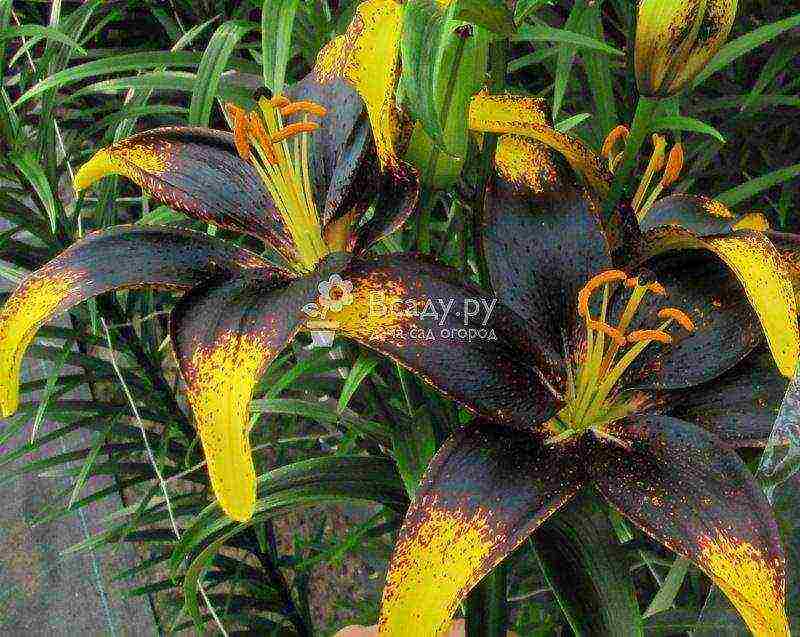 Lily Lion Heart has a defiant color
Lily Lion Heart has a defiant color
Annamarie Dream
Medium-sized variety, up to 60 cm. Peduncle bears 7-9 buts. The flower is terry, medium-sized, without specks, with bright burgundy stamens in the center and white or white-cream colored petals.
Asian lily hybrid - Annamiria Dream variety
Black Out (Russian Black Out)
Tall variety, 110-125 cm. Deep red color gives flowers extraordinary beauty. The petals are glossy, with dark specks. The main vein on them is expressed in a darker color, up to blue-black.
Garden lily Black Out has a deep red color
Lollupop (Russian Lollipop)
Representatives of this variety are medium-sized (90-100 cm). Large flowers are two-colored (white in the center and with bright pink or crimson tips), without specks, located in inflorescences of 3-5 pieces. A distinctive feature of this variety is its large bulbs.
Lily variety Lollypop - a bright representative of Asian hybrids
Flore Pleno
Describing the types of garden lilies, one cannot fail to mention the Flora Pleno variety. It is tall, up to 120 cm, a representative of Asian hybrids with thick double flowers and petals bent upwards. The color of the flowers is fiery orange with tiger specks all over the petal.
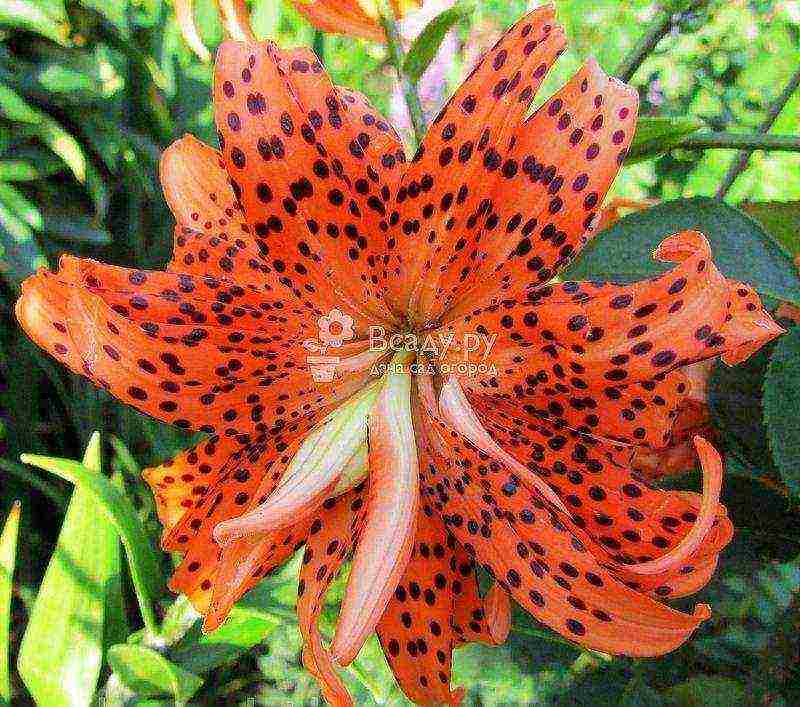 Lily variety Lollypop - a bright representative of Asian hybrids
Lily variety Lollypop - a bright representative of Asian hybrids
Flore Pleno blooms in July. It does not form seeds, but babies (heads, or bulbs) are formed in the leaf sinuses for reproduction.
Oriental hybrids of lilies - varieties and description
All types of garden lilies, photos and descriptions of which are discussed in the catalog, have their own characteristics. Thus, oriental hybrids are distinguished by large flowers and an unusually enchanting aroma. Compared to other types of lilies, they are very demanding on the growing conditions and wintering of bulbs. They bloom later than Asian hybrids, in July-August.
Lovely Girl
The oriental hybrid of the Lovely Girl variety is famous for its extraordinary beauty. It is a medium-sized variety, 70-80 cm high. The flowers are large, can reach 20 cm in diameter. The color of the flowers is cream, with a bright yellow longitudinal spot along the entire length of the petal and red specks. The edges of the petals are wavy.
Popular variety of oriental hybrid lilies - Lovele Girl
Magic Star (Russian Magic Star)
Beautiful oriental lilies, the varieties, photos and descriptions of which we are considering, are the dream of every gardener. Magic Star is no exception, a medium-sized variety, up to 100 cm in height. The flowers really resemble a magic star - densely double, up to 20 cm in diameter. Their color is pink with a bright crimson spot along the petal and a rare speck. The edging of the petals is white, corrugated.
Oriental lily Magic Star
Barbados (Russian Barbados)
The famous variety of Barbados in all its glory represents oriental varieties of lilies, photos of which illustrate their extraordinary beauty. Stem 90-110 cm high bears up to nine large buds. Flowers up to 25 cm in diameter, rich crimson with specks and white edging along the wavy edge.
Lily variety Barbados is unusually beautiful
Casablanca (Russian Casablanca)
Tall, up to 120cm, a representative of oriental lilies with a heady aroma. The flowers are very large, up to 25 cm, snow-white, without specks. Up to 9 flowers bloom on each stem at the same time.
Lily Casablanca has a large number of flowers on the stem
Extravaganza (Russian Extravaganza)
The Extravaganza variety is famous for its fragrant, delicate and very large flowers. Their color is white with a pale pink longitudinal stripe and bright specks. The petals are moderately corrugated and slightly bent. Oriental garden lilies, varieties, photos and characteristics of which are described in the article, will certainly become a decoration for a garden decorated in any style.
Lily Extravaganza is valued for its aroma and beautiful delicate buds Hybrids of lilies Longiflorum Asiatic
Modern hybrids, bred relatively recently, have absorbed the best qualities of their specific ancestors. LA hybrids, or Longiflorum Asiatic hybrids, are a modern group of varieties that breeders have obtained by crossing representatives of long-flowered and Asian species. These garden lilies, varieties, photos, and descriptions of which are presented in the article, delight with large flowers with a delicate aroma, firmly endure all the vagaries of the weather, and are suitable for distillation.
Indian Diamond
In height, this representative can reach one and a half meters. Large bright orange flowers without specks. 7-9 buds on the stem are directed both upward and to the sides, and create an incredibly beautiful orange "hat".
Indian Diamond attracts with bright orange blossom
Ceb Dazzele (Russian Keb Dazzle)
The stem of this variety of lilies bears 5-7 buds and reaches a height of 100-110 cm. Bright yellow flowers with a rare speck at the base are directed upwards.
Keb Dazzle is a tall hybrid of a lily with bright flowers
Samur (Russian Samur)
Spectacular LA hybrid. The bush is very powerful, purple flowers with a white center and dark crimson edging.
Samur - LA hybrid with large purple flowers Oriental Trumpet hybrid group
Tubular and Oriental lily species were taken by breeders to develop hybrid varieties of the Oriental Trumpet group. Large flowers are brightly colored in various shades. Flowers are located in groups of 12-15 pieces.
Black Beauty
One of the first to represent the group, which includes OT hybrids, the Black Beauty lily variety, its photo is amazing, but does not convey all its beauty. A high, up to 2 m stem bears many buds. The flowers are turban-shaped, painted in cherry color with a greenish spot at the base and a white edging. Dark papillomas are present on the petals.
Black Beauty variety is one of the most beautiful OT hybrids
Northern Carillon
This lily variety can be safely called legendary. For many years, it was considered the best OT hybrid of Canadian breeding. In spring, the leaves of this lily are crimson. The flowers are drooping, white with a bright crimson center. One stem has up to 20 flowers, the size of which can reach 30 cm in diameter.
Variety of Canadian selection Northern Carillon
Shocking
Stems 80-100 cm in height are leafy. The flowers are multiple muted yellow or peach in color with bright red strokes. The throat of the flower is light green with red specks. Lilies of the variety, the photos of which are presented below, will make a splash in your garden.
Shocking lilies will look perfect in any garden The best varieties of lilies for Siberia and the Urals
Lilies are grown not only in the southern regions, but also in the difficult climatic conditions of Siberia and the Urals. Frost-resistant varieties of lilies for Siberia, photos and names of which you will find in our article, are not afraid of sharp climatic changes and calmly endure cold winters.
In cold regions, LA hybrids are grown, varieties of curly lilies, Asian hybrids, photo varieties and names of which are described in this article. Hybrids of curly lily or Martagon are very hardy, grow on any soil and are not pretentious in care.
Lily Kudrevataya is suitable for growing in Siberia.
The stems of Martagon lilies are tall, the flowers are usually turban-shaped, not large. The color of the flowers is varied - from light pink to lilac with many shades. Orange flowers of the Nicotine variety with lilac specks are also suitable.
The Martagon group is a bright and unusual variety of Nicotine
Some varieties of oriental hybrids with increased frost resistance are also chosen for cultivation in Siberia. Among them is the Siberia variety with white corrugated flowers.
Eastern hybrid - Siberia variety has increased frost resistance
Outcome
It is impossible to list all the varieties and types of lilies with photographs and descriptions, so we told you about the most demanded and popular of them among gardeners. We are sure that from all the variety of these incredibly beautiful flowers, you will find those that will please your taste and will delight you in the garden for many years.
Asian hybrids are the most common lilies in our gardens. They are all very hardy, grow well and adapt to adverse conditions. But how to choose the most spectacular from the rich variety of varieties?
The flowers of Asian lilies can be of various colors, while they often combine two or even three tones. This makes the large bud even more attractive. Thanks to this variety, you will choose flowers to your taste so that they fit harmoniously into your garden design.
Up to 30 flowers can be placed on one lily stem. They usually do not exude the rich and sugary-sweet aroma characteristic of most lilies, but they look no less attractive.
All Asiatic lilies are unpretentious in care and endure frost up to -40 ° С. They grow best on neutral or slightly acidic and well-fertilized soils.
So, let's see which hybrids of Asian lilies have gained the most popularity among flower growers.
1. Aphrodite
This extraordinarily beautiful lily is originally from Holland. Aphrodite has large double flowers with elongated petals of a pale pink color without blotches. One inflorescence contains 20-30 pieces. The width of the bush is about 50 cm.
|
Appointment |
Plant height (cm) |
Flower diameter (cm) |
Flowering period |
Peculiarities |
|
|
80-110 |
13-15 |
June July |
Prefers loose acidified sandy-clayey soil with coniferous litter |
2. Golden stone
This graceful lily has lemon-yellow flowers directed upwards and densely covered with red-cherry specks in the center. The flower shape is star-shaped.
|
Appointment |
Plant height (cm) |
Flower diameter (cm) |
Flowering period |
Peculiarities |
|
|
110-120 |
July |
In the first year needs in shelter |
|
3. Detroit
Bright, scarlet flowers (sometimes with a yellowish-orange throat) create an elegant accent in the flower garden. The buds are directed upwards and slightly to the side. The edges of slightly curved petals are straight or serrated. Dark red pollen forms on the green-yellow stamens.
|
Appointment |
Plant height (cm) |
Flower diameter (cm) |
Flowering period |
Peculiarities |
|
|
90-120 |
12-17 |
June July |
In the first year needs in shelter |
4. Lollypop
Delicate and bright flowers of Lollipop attract many views. The tips of the petals are purple-crimson, and the middle of the bud is snow-white with small brown-purple specks. Greenish stamens are covered with large brown-orange pollen. Inflorescences are small, on one stem there are 3-5 flowers in the form of a wide bowl.
|
Appointment |
Plant height (cm) |
Flower diameter (cm) |
Flowering period |
Peculiarities |
|
|
70-90 |
11-15 |
June July |
Blooms later 70 days after germination; withstands frost down to -25 ° С |
5. Mapira
This lily will become the highlight of your garden. Its large flowers of a luxurious maroon (and sometimes almost black) color with orange stamens look very impressive both in a flower bed and in bouquets.
On a strong stem, there are from 5 to 15 buds, which bloom gradually, replacing each other. The flowers are directed upward and to the side.
|
Appointment |
Plant height (cm) |
Flower diameter (cm) |
Flowering period |
Peculiarities |
|
|
80-120 |
Before 18 |
July |
In the first year needs in shelter |
6. Marlene
This unique variety fell in love with flower growers for its pronounced tendency to mutation (fasciation), as a result of which a huge number of flowers are formed - about 100 pieces per plant. Such a profusely flowering lily can be obtained as early as the second year after planting. However, this is not guaranteed, since fasciation is an unpredictable phenomenon.
Usually, up to 15 pale pink flowers are formed on one strong stem of Marlene lily. Sometimes the buds are light yellow in the center.
|
Appointment |
Plant height (cm) |
Flower diameter (cm) |
Flowering period |
Peculiarities |
|
|
90-110 |
10-15 |
End of June - July |
Fascicating lily needs to garter stem and abundant dressing |
7. Spring pink
The flowers of this hybrid lily are double, pale pink, sometimes almost white. Often the petals are slightly “powdered” with a characteristic purple speck and are framed by a border. One inflorescence contains about 30 buds.
This variety is similar in its characteristics to Marlene: due to the same mutation, the number of pale pink flowers on the stem can reach 100. True, this phenomenon is less common in Spring Pink.
|
Appointment |
Plant height (cm) |
Flower diameter (cm) |
Flowering period |
Peculiarities |
|
|
50-100 |
12-15 |
End of June - July |
With fasciation requires additional dressing and garter stalk |
8. Tinos
This spectacular lily gained popularity due to the unusual color of the flower: yellow-orange and crimson strokes are applied on a white or cream bud, like a brush. As a rule, 6-7 flowers appear on one strong stem.
|
Appointment |
Plant height (cm) |
Flower diameter (cm) |
Flowering period |
Peculiarities |
|
|
100-120 |
Up to 16 |
July August |
Bright coloration flower manifests itself only when growing on solar sites |
9. Fata Morgana
It is one of the most popular varieties of Asiatic lilies. Terry flowers with 12 lemon-yellow petals, a quarter covered with large dark red specks, leave no one indifferent. The bowl-shaped flowers are directed upwards. They lack anthers.
There are usually 7-9 flowers on one green stem, but sometimes their number can reach up to 20.
|
Appointment |
Plant height (cm) |
Flower diameter (cm) |
Flowering period |
Peculiarities |
|
75-95 |
13-16 |
July August |
Grows well like the sun and in partial shade |
|
As a result of crossing Asian lilies with long-flowered lilies, no less attractive so-called LA hybrids appeared. You can read more about them in this article.
 Nature gave these flowers beauty and sophistication of forms. Modern hybrids of lilies, varieties with photos and names given below, could not exist without the painstaking work of scientists and amateur flower growers.
Nature gave these flowers beauty and sophistication of forms. Modern hybrids of lilies, varieties with photos and names given below, could not exist without the painstaking work of scientists and amateur flower growers.
Breeding work made it possible to obtain plants:
- with incredibly large and bright colors;
- with flowering lasting for 4-6 weeks;
- with the color of the petals, impossible in nature.
Enthusiasts collecting collections of garden and potted lilies can boast of plants only 20 cm high and amaze spectators with huge two-meter "trees". And the stems of lilies, depending on the variety and type, at the height of summer are crowned with from one to a hundred buds of all shades of the rainbow.
Thanks to the creation of interspecific hybrids, flower growers have the opportunity to grow flowers painted in white, pink, orange, deep burgundy and even greenish tones. Brief descriptions with names and photos of varieties of lilies will help you choose the best one-color, two- and even three-color varieties for your flower bed.
Lily varieties with red flowers
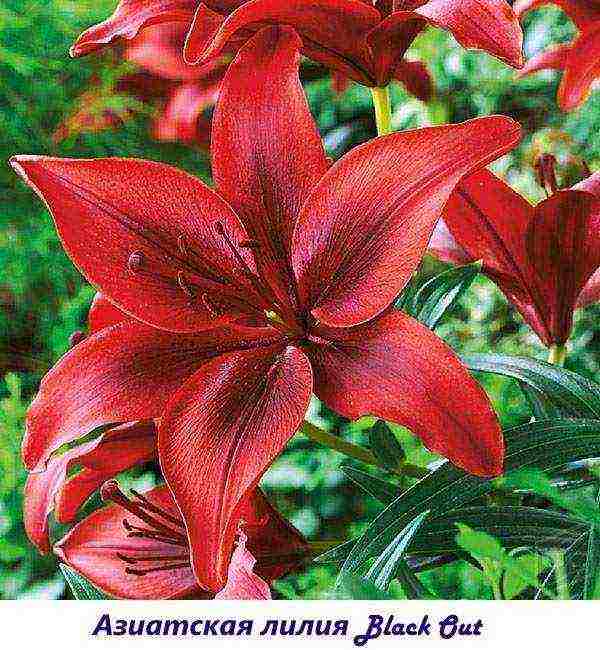 Lilies with bright red, purple, crimson petals will not go unnoticed even in the most variegated and densely populated flower bed. The large-flowered varieties offered by breeders are doubly effective. Their corolla sizes reach 15, and sometimes 20 cm, and at the tops of the stems up to a dozen bright buds flaunt at the same time.
Lilies with bright red, purple, crimson petals will not go unnoticed even in the most variegated and densely populated flower bed. The large-flowered varieties offered by breeders are doubly effective. Their corolla sizes reach 15, and sometimes 20 cm, and at the tops of the stems up to a dozen bright buds flaunt at the same time.
The Black Out lily, belonging to Asian hybrids, will be a real boon for summer residents. The plant blooms a little more than a meter in June, and until the end of July, large, simple, dark-red flowers sway on densely leafy stems. Reminiscent of stars, the upward-looking corollas in the center are noticeably darker. The purple or black tint emphasizes the depth of the flower with a diameter of about 15 cm.
Sensitive natures will appreciate the important quality of Asian lilies and hybrids. They are completely odorless.
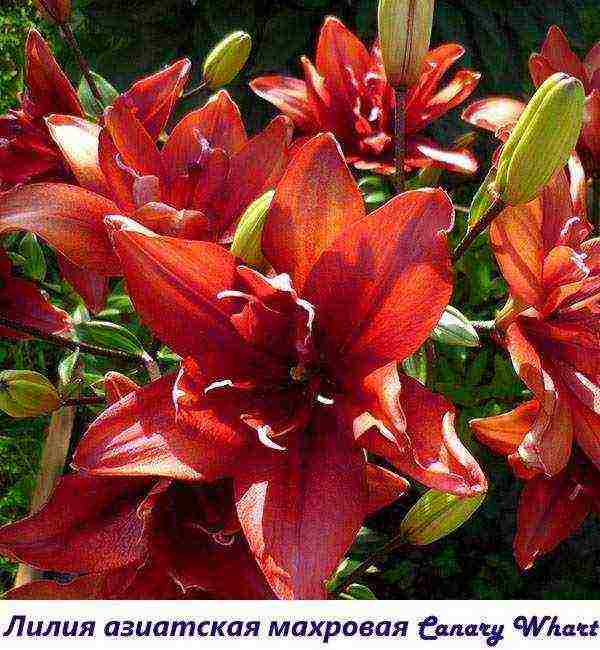 Terry lilies of a rich red tone are a living embodiment of fire. Newbies, choosing this or that variety, mistakenly believe that only an experienced florist who gives all his strength to the inhabitants of flower beds can grow such a beauty on the shoulder.
Terry lilies of a rich red tone are a living embodiment of fire. Newbies, choosing this or that variety, mistakenly believe that only an experienced florist who gives all his strength to the inhabitants of flower beds can grow such a beauty on the shoulder.
The Canary Worf double lily will not take much time and effort, while every summer it will delight you with consistently lush flowering. The height of the plant is 90 cm.The glossy dark red petals are collected in spectacular corollas with a diameter of 12 to 14 cm.
Asiatic lilies are distinguished by their unassuming disposition, they:
- are not afraid of frost;
- tolerate drought quite easily;
- bloom continuously for 3-5 weeks;
- do not require annual replanting and digging for the winter.
You can propagate your favorite variety by dividing an adult plant or planting small bulbs that form in the leaf axils.
 Another variety that deserves close attention is the marchon lily, curly, Turkish, or the royal curls lily familiar to many. The plant owes its specific name to the ancient Roman epic, namely the moment of birth from a flower of the god Mars. Popular nicknames are a hint of the shape of the swirling petals and the turban-like shape of the corollas.
Another variety that deserves close attention is the marchon lily, curly, Turkish, or the royal curls lily familiar to many. The plant owes its specific name to the ancient Roman epic, namely the moment of birth from a flower of the god Mars. Popular nicknames are a hint of the shape of the swirling petals and the turban-like shape of the corollas.
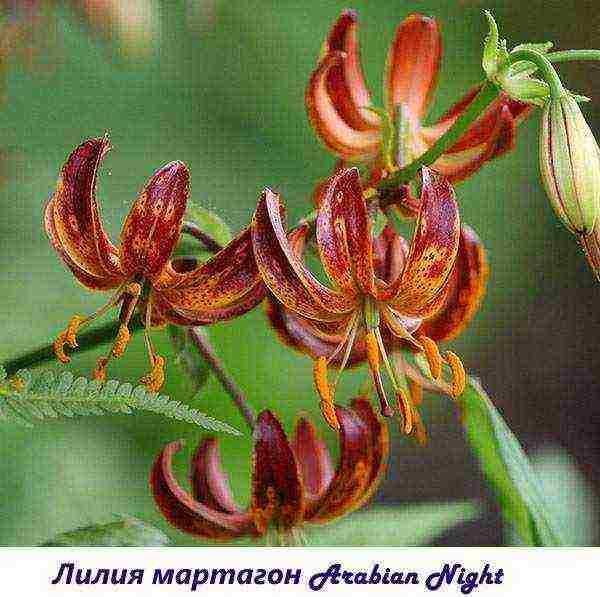 Spectacular speckled corollas form large racemose inflorescences on high stems. At the disposal of flower growers today there are a lot of interesting varieties of this variety with buds of white, pink, golden and red tones.
Spectacular speckled corollas form large racemose inflorescences on high stems. At the disposal of flower growers today there are a lot of interesting varieties of this variety with buds of white, pink, golden and red tones.
Lily Arabian Nights will decorate any garden. Flowers of a dense wine-red hue are strewn with bright yellow specks. The gilding effect is supported by large anthers. The long bloom is accompanied by a scent that attracts both daytime and nocturnal insects.
 The hybrid lily African Lady with red petals encircled by a yellowish-cream border can boast of unusually lush bloom and luxurious flowers. The variety belongs to complex hybrids. From eastern ancestors, the plant received a characteristic color and flowers with slightly corrugated edges, as well as flowering in the second half of summer. At the same time, lily stems grow only up to a meter in height, which allows the lily to be used both in group plantings, and as the main decoration of a flower bed.
The hybrid lily African Lady with red petals encircled by a yellowish-cream border can boast of unusually lush bloom and luxurious flowers. The variety belongs to complex hybrids. From eastern ancestors, the plant received a characteristic color and flowers with slightly corrugated edges, as well as flowering in the second half of summer. At the same time, lily stems grow only up to a meter in height, which allows the lily to be used both in group plantings, and as the main decoration of a flower bed.
Photos and names of lilies with yellow flowers
 Like the summer sun, the summer cottages are illuminated by yellow lilies of various varieties and varieties.Lily Jive, belonging to Asian hybrids, is distinguished by its versatility, long flowering period and undemanding care. Plants, growing from 90 to 120 cm, bear 3–7 bright yellow flowers. The center of the rim is decorated with red plating. The anthers are colored red-brown.
Like the summer sun, the summer cottages are illuminated by yellow lilies of various varieties and varieties.Lily Jive, belonging to Asian hybrids, is distinguished by its versatility, long flowering period and undemanding care. Plants, growing from 90 to 120 cm, bear 3–7 bright yellow flowers. The center of the rim is decorated with red plating. The anthers are colored red-brown.
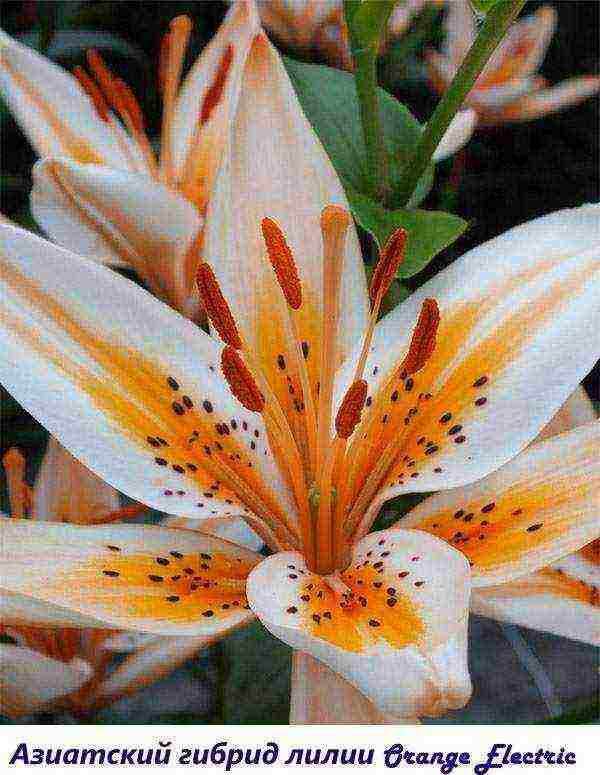 The Orange Electric lily with white flowers with a diameter of 14 to 16 cm can become a neighbor in the flower garden for the previous variety. The central part and base of the petals are covered with juicy strokes of a ripe tangerine shade. Brownish-red dots are scattered on top, giving the flower the appearance of a surprisingly bright dessert.
The Orange Electric lily with white flowers with a diameter of 14 to 16 cm can become a neighbor in the flower garden for the previous variety. The central part and base of the petals are covered with juicy strokes of a ripe tangerine shade. Brownish-red dots are scattered on top, giving the flower the appearance of a surprisingly bright dessert.
This Asiatic lily grows up to 120 cm, and on its strong shoots up to 12 buds open at the same time.
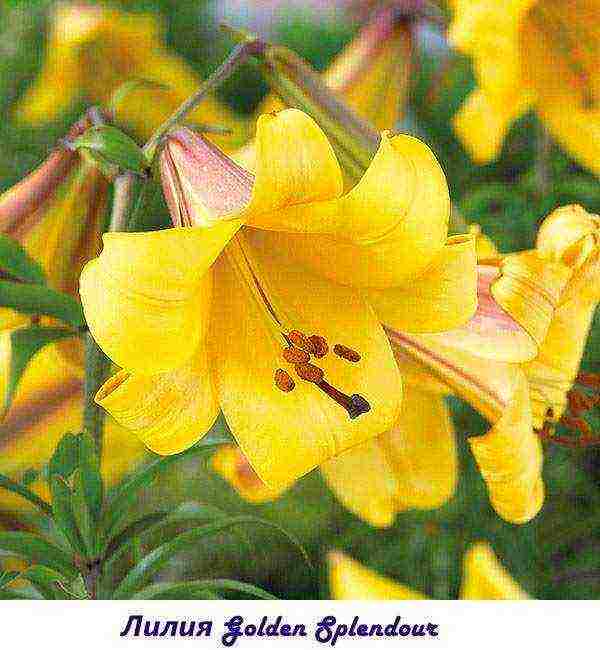 All lilies are unique, but some plants are truly unique. An example is the Golden Splendor lily with flowers of a sunny golden yellow hue.
All lilies are unique, but some plants are truly unique. An example is the Golden Splendor lily with flowers of a sunny golden yellow hue.
A variety, or rather a group of varieties, belongs to tubular hybrids, as evidenced by a strong aroma, structure, flowers and leaves, as well as a pinkish-purple shade of the outer side of the petals. The plant presented to the public in 1982 amazed connoisseurs. The fact is that in nature, yellow tones on the flowers of tubular lilies can be found only in the very depths of the throat. It was possible to give a golden color to the entire bud only thanks to crossing with the species Henry lily.
Today, the flowers used to decorate gardens and cut flowers are known all over the world, and the group, in addition to the Golden Splendor lily, includes about a dozen more spectacular varieties.
 The yellow Hanimun lily is the result of a cross between oriental and tubular varieties. The plant received from its ancestors:
The yellow Hanimun lily is the result of a cross between oriental and tubular varieties. The plant received from its ancestors:
- outstanding size;
- aroma;
- striking decorativeness.
An OT hybrid with creamy yellow flowers up to 25 cm in diameter is less demanding to care for than its eastern ancestors, but in warm regions, with regular watering and feeding, it can grow much higher than the 90 cm indicated in the description of the variety.
 However, the Big Brother OT hybrid is rightfully considered the champion among yellow lilies. Both the photo of the lily and the name of the variety eloquently say that one should expect a florist who has planted large whitish bulbs on his flower beds.
However, the Big Brother OT hybrid is rightfully considered the champion among yellow lilies. Both the photo of the lily and the name of the variety eloquently say that one should expect a florist who has planted large whitish bulbs on his flower beds.
With proper care, the stems rise 150–180 cm above the ground level, and the buds that unfold on them are impressive not only in size. Big Brother lily petals are painted in creamy vanilla tones with a golden central stripe and a lighter, almost white border. The flowers give off a strong aroma and stand perfectly in the bouquet. The best place to plant such a plant is a sunny or partially shaded area with loose, fertile soil, where the bulbs will not be threatened with stagnant water.
It is important that lilies have protection from strong winds that can break tall stems with heavy buds.
Black lilies
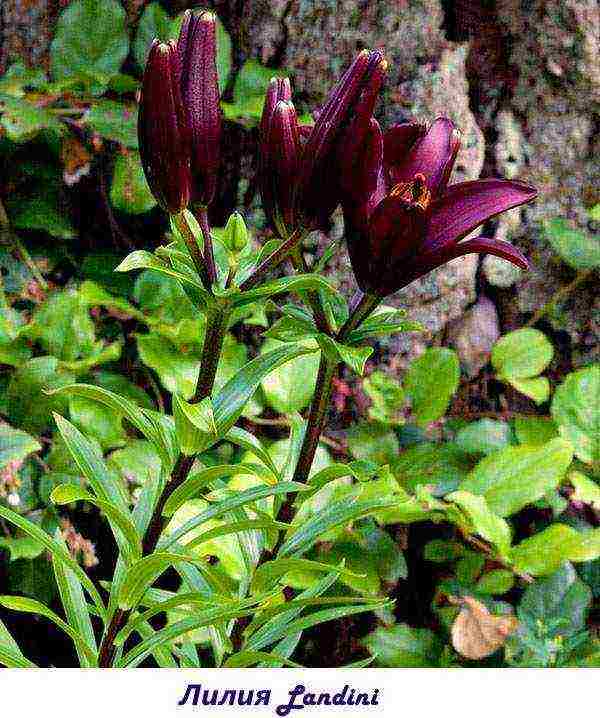 Of course, absolutely black colors do not exist. But there are varieties of lilies, thanks to their thick, purple-violet color, that have every right to be called that.
Of course, absolutely black colors do not exist. But there are varieties of lilies, thanks to their thick, purple-violet color, that have every right to be called that.
Asiatic lily Landini has a rare black and burgundy color of large corollas up to 16 cm in diameter. The flowers, facing the sun, shimmer and sparkle under its rays, arousing the admiration of everyone who has time to admire the magnificent plant from June to July.
 Lily Night Ryder is no less spectacular. The variety, referred to the group of Asian hybrids, is unpretentious, is not afraid of winter cold, spring frosts, blooms regularly and for a long time. The peculiarity of the plant is suitability for forcing in pots. You can grow a luxurious flower on a stem up to 90 cm at home, on a balcony or terrace.
Lily Night Ryder is no less spectacular. The variety, referred to the group of Asian hybrids, is unpretentious, is not afraid of winter cold, spring frosts, blooms regularly and for a long time. The peculiarity of the plant is suitability for forcing in pots. You can grow a luxurious flower on a stem up to 90 cm at home, on a balcony or terrace.
 Black Charm lily amazes with powerful inflorescences uniting up to two dozen buds. This variety gives off silky petals, iridescent in all shades of purple, purple, red, wine. In general, the flowers give the impression of being black, one of the darkest in Asiatic lilies.
Black Charm lily amazes with powerful inflorescences uniting up to two dozen buds. This variety gives off silky petals, iridescent in all shades of purple, purple, red, wine. In general, the flowers give the impression of being black, one of the darkest in Asiatic lilies.
Varieties of white lilies
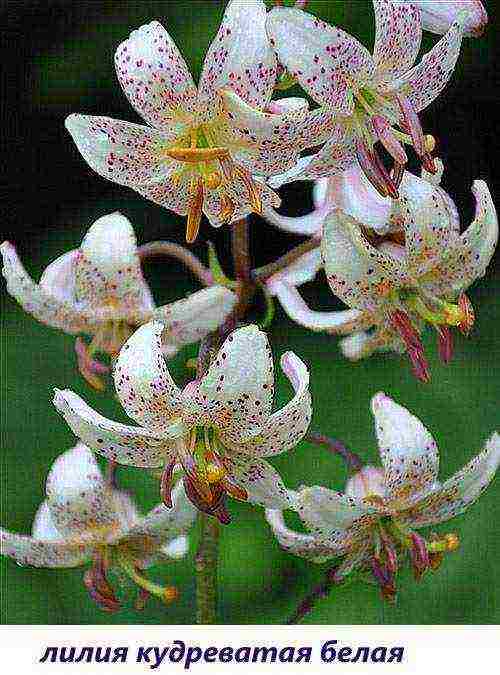 Everyone is familiar with the fragrant snow-white lilies.But luxurious tubular hybrids are not the only representatives of the genus with a white coloration.
Everyone is familiar with the fragrant snow-white lilies.But luxurious tubular hybrids are not the only representatives of the genus with a white coloration.
Flowers with delicate white petals and a scattering of pinkish-carmine spots will be presented to the summer resident by a curly lily. These plants do not require frequent replanting, they winter well and bloom for a long time, pouring a delicate aroma over the garden.
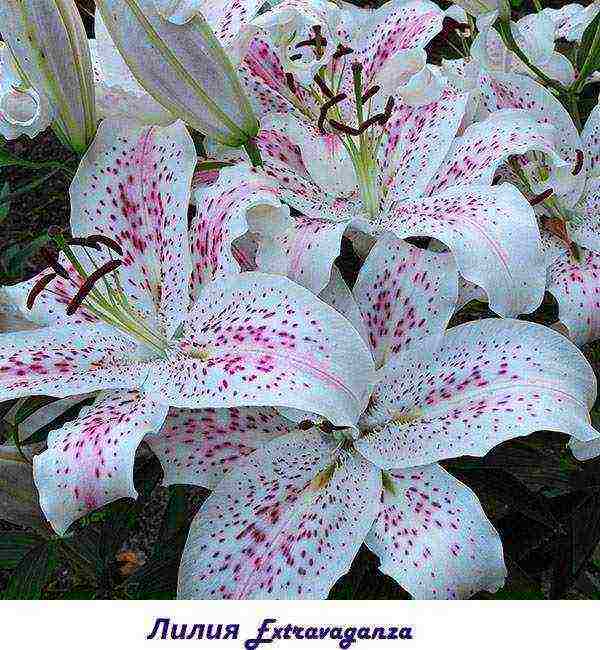 If the gardener is a fan of lush oriental hybrids, he will like the original Extravaganza lily. Like the closest related forms, the plant stands out with stems up to 120–150 cm high and huge white corollas covered with bright pink splashes. Flowers with gracefully curved, wavy petals at the edges have a diameter of up to 25 cm, while they tolerate cutting very steadily and can be used in bouquets. The splendor of the variety is appreciated by specialists. Lily Extravaganza won a gold medal at Harts Nursery.
If the gardener is a fan of lush oriental hybrids, he will like the original Extravaganza lily. Like the closest related forms, the plant stands out with stems up to 120–150 cm high and huge white corollas covered with bright pink splashes. Flowers with gracefully curved, wavy petals at the edges have a diameter of up to 25 cm, while they tolerate cutting very steadily and can be used in bouquets. The splendor of the variety is appreciated by specialists. Lily Extravaganza won a gold medal at Harts Nursery.
The flowering of oriental hybrids most often takes place in the second half of summer, and with the onset of cold, the plants must be covered.
 A summer resident who does not have so much time to take care of flowers will definitely appreciate the White Pixels lily variety. The Asian variety from the Dutch Tango series is not only unpretentious and frost-resistant. Snow-white flowers with a dense crimson dusting are very beautiful. In full dissolution, they reach a size of 15 cm and decorate flower beds for up to 2-4 weeks.
A summer resident who does not have so much time to take care of flowers will definitely appreciate the White Pixels lily variety. The Asian variety from the Dutch Tango series is not only unpretentious and frost-resistant. Snow-white flowers with a dense crimson dusting are very beautiful. In full dissolution, they reach a size of 15 cm and decorate flower beds for up to 2-4 weeks.
 Crossing of Asian and long-flowered lilies made it possible to obtain original and unpretentious LA hybrids. One of them is Eyeliner lily, up to 120 cm high with creamy white flowers with a diameter of about 18 cm. White petals are decorated with a thin neat border, thanks to which the variety got its name.
Crossing of Asian and long-flowered lilies made it possible to obtain original and unpretentious LA hybrids. One of them is Eyeliner lily, up to 120 cm high with creamy white flowers with a diameter of about 18 cm. White petals are decorated with a thin neat border, thanks to which the variety got its name.
Pink lilies: varieties and photos
 From tubular and oriental varieties, breeders have received the incredibly popular OT hybrids today. Plants, which took spectacular colors and large sizes from oriental lilies, turned out to be majestically beautiful and hardy.
From tubular and oriental varieties, breeders have received the incredibly popular OT hybrids today. Plants, which took spectacular colors and large sizes from oriental lilies, turned out to be majestically beautiful and hardy.
Lily Scheherazade, originally from Holland, grows well in slightly acidic loose soil, rich in nutrients and not allowing moisture to stagnate. A tall variety needs protection from the wind and good heating. On the sunny side, flowers with dense pink petals, a greenish-white border and dark specks reach a size of 18–20 cm.
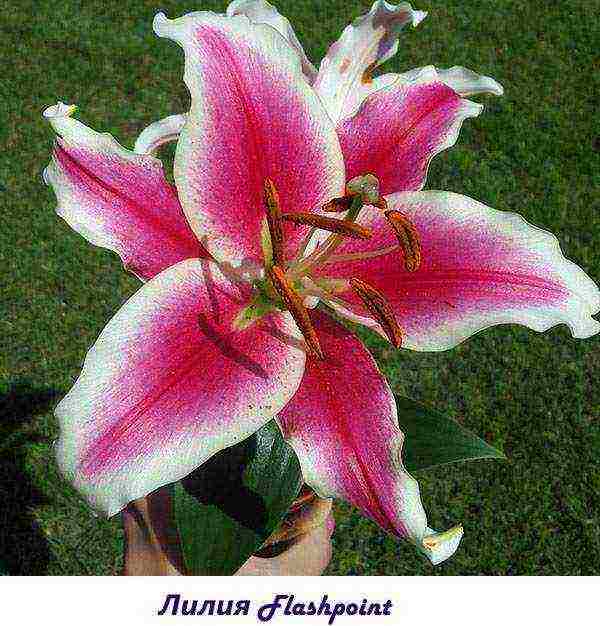 No less delight of florists is the Flashpoint lily with flowers up to 20 cm in diameter. White, slightly wavy petals are decorated with a large crimson-pink spot. In the throat of the cupped corolla, greenish-yellow tones are noticeable, anthers are dark orange. Lilies bloom in August. The flowers can be cut if desired. They will delight you with their beauty and freshness in a vase for a long time.
No less delight of florists is the Flashpoint lily with flowers up to 20 cm in diameter. White, slightly wavy petals are decorated with a large crimson-pink spot. In the throat of the cupped corolla, greenish-yellow tones are noticeable, anthers are dark orange. Lilies bloom in August. The flowers can be cut if desired. They will delight you with their beauty and freshness in a vase for a long time.
 The second half of summer is the time of flowering of another OT hybrid with delicate pink corollas up to 25 cm in diameter. This is the Baywatch lily, the stems of which rise 100-120 cm above the flower bed, and the coral-pink cupped flowers with a lemon heart spread an amazing aroma throughout the garden.
The second half of summer is the time of flowering of another OT hybrid with delicate pink corollas up to 25 cm in diameter. This is the Baywatch lily, the stems of which rise 100-120 cm above the flower bed, and the coral-pink cupped flowers with a lemon heart spread an amazing aroma throughout the garden.
Lilies with green flowers
 The international classification of garden lilies describes several thousand Asiatic lilies, making these hybrids the most common. The reason for the popularity is the simplicity of plants of various colors and their willing flowering.
The international classification of garden lilies describes several thousand Asiatic lilies, making these hybrids the most common. The reason for the popularity is the simplicity of plants of various colors and their willing flowering.
Even in such a variety, the Mystery Dream lily will never go unnoticed. The variety is distinguished by a densely doubled flower shape and its unusual color. The greenish petals are covered with specks and spots of a rich crimson-purple hue.
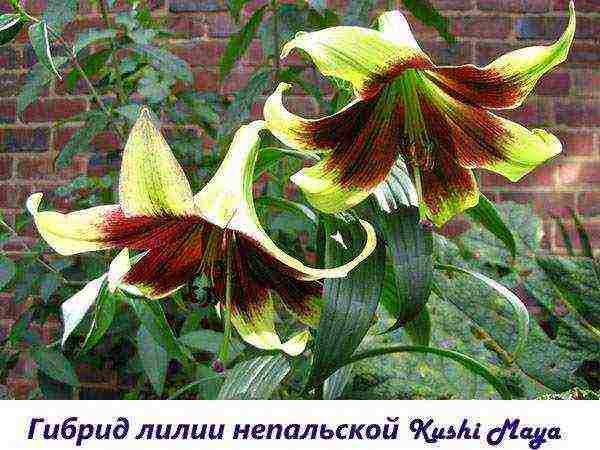 The Kushi Maya lily with exquisitely folded petals in a light green hue and a purple spot in the center of the corolla is the result of a cross between the species Nepalese and oriental lilies. The original beauty of the plant is supported by a strong aroma of flowers and more endurance than that of the oriental ancestors.
The Kushi Maya lily with exquisitely folded petals in a light green hue and a purple spot in the center of the corolla is the result of a cross between the species Nepalese and oriental lilies. The original beauty of the plant is supported by a strong aroma of flowers and more endurance than that of the oriental ancestors.
Lily exhibition - video


